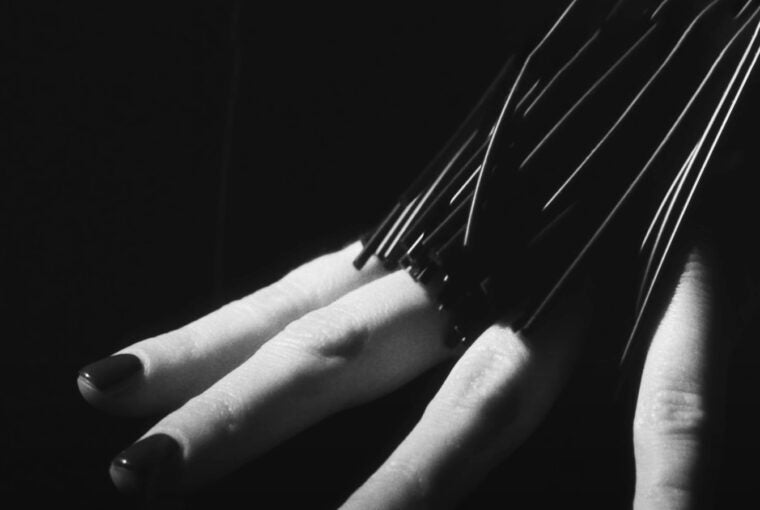
KINK 101: It Doesn't Have to Hurt!
Share
By Lauren Moore
50 Shades seems to have sparked everyone's curiosity about what might be in the bedroom, BDSM wise.
But their interest quickly fades when they realize there might be pain involved. That's okay. Pain isn't necessary to get started in kinkdom. There's something in kink for everyone, even the shyest!
Many people define kink as a broad topic that encompasses all taboo sex, but when you get around to seeing or participating in a scene (a fancy name for a kinky interaction), it's theatrical and a series of onomatopoeia, like whip, slap, thud, and gasp! This frequently includes pain, but what if you don't like pain? I'm here to tell you it doesn't have to. Here's a kink 101 guide for the pain-avoidant, the curious, and everyone in between.
WHAT IS KINK?
Again, the simplest definition I have for you is that it's an umbrella term that encompasses all consensual, taboo sex. Since what's considered "taboo" is cultural, many things may be taboo for some, but not even remotely so for others; a prime example is anal sex. Universally, kink includes fetishes and BDSM. It can be a fantasy, a practice, or an identity. People can call themselves kinky if they practice it occasionally on the weekends, in specific relationships, or all the time.
For the purposes of this article, I'm going to focus on the BDSM aspect of kink-dom. Fetishes are a hyper-fixated attraction to one thing (hey, I'm not looking at your shoe collection when I say this), and since they're usually tied to specific life events, I don't need to spell that out for you. BDSM, however, is a broad community and set of behaviors that fall into categories like bondage/discipline, dominance/submission (capitalization intended), and sadism/masochism. These are the practices that have leeway to explore pain and painless fun.
WHY DO PEOPLE LIKE PAIN? OR PERVERSION?
Kink offers you the opportunity to learn, lose, or gain something about yourself. You can try a new sensation (like being spanked) or a new role (like dominating another person). Many people find their kink practices cathartic and liberating.
As for why certain people like certain sensations, I couldn't tell you: each person is unique. What I can tell you is that our biology and experience change how we perceive sensations on our skin. Think about having your nails run over your skin. My partner finds it ticklish and doesn't like it (common for redheads like him); I find it ticklish and/or painful due to tiredness and hormones and I do like it*; both of us, if someone started doing it without consent, wouldn't like it. Try it on your own arm: does it only tickle you? Does the sensation change the longer you do it? Does it change if someone else does it? As this article about pain says, pain is weird and very contextual.
IF KINK IS WHIPS AND CHAINS, HOW DO YOU KINK WITHOUT PAIN?
Oh, I love Rihanna's S&M, and even the title is spot on! Sadism and masochism focus on giving and receiving pain (and whips and chains are particularly potent ways to inflict pain). You might one day like it, like I like fava beans... it might happen, but I wouldn't bet on it. That's okay. There's a whole world of BDS to focus on.
The B, as in bondage, is my favorite introduction to pain-free kink. It takes practice, but knots are a fun party trick (at the right parties) and can be very versatile. It holds things and people in place, can be a fun sensation against the skin, and creates a squeezing feeling. Compression is a pretty universal pleasurable sensation—like a Thunder Jacket for people!
Beyond bondage, there are sensation games that can include tickling, wax play, sex with food, sex WITH food, hot and cold play, and much more! There are also kinks related to sex in certain places or with certain people.
Even if you're curious about whips and chains, you should know that there are less painful options than others. I could write a separate article on how to buy floggers, but for now, let's emphasize getting something with high falls (aim for 24-40 falls) or leather lengths, like a flogger, over a whip or crop. Leather is always a better option than wood or plastic materials. Choose something the length of your arm or a few inches shorter.
Finally, there is D/s play, which is a very cool and large world to play in without pain.
WHAT IS D/S GAME?
D/s is Dominance/Submission: While sadomasochism focuses on giving and receiving pain, D/s focuses on giving and receiving power. This means that someone directly directs the course of a sexual encounter, and another person obeys. Traditional schoolgirl and nurse fantasies fit here. You can incorporate bondage, pain, and all of the above into D/s play, but you should think of D/s as a theatrical performance. How would I act if I were a confident, dominant person? How would I act if I were subservient, bratty, or quiet?
This game is often aligned with humiliation play, which is what it sounds like: if someone is very masculine, you might make them wear feminine clothes or do feminine things. Catharsis comes from subverting the experiences people usually have. Depending on how far you take it, this can be emotional pain play; however, this is very advanced and not recommended for the people reading this article.
With all D/s and kink play, I recommend people read up on the topic before trying it. Talking to staff at small, feminist sex toy stores also helps. Above all, consent is crucial: knowing what you're doing, knowing when to stop, knowing what you and your partner consider fun.
You should also know that this skims the fun and tantalizing surface (is that a skin pun?) of kink. For more on these and other topics, I recommend books like The Ultimate Guide to Kink or 50 Shades of Kink: An Introduction to BDSM by Tristan Taormino, and As Kinky as You Wanna Be by Shanna Germain. Edited books are great for getting key expert perspectives on many topics—a great appetizer for your chosen main course! Happy gaming!
*As little as we know about pain, we know even less about tickling. As best I can find, tickling uses the same physical and neural pathways as pain receptors, and our laughter is hardwired to us coming from apes expressing fear... which seems like a stretch to me, but you can learn more here .
**Please, we do not tolerate lawbreaking or infidelity. The consent of all parties involved is important.
